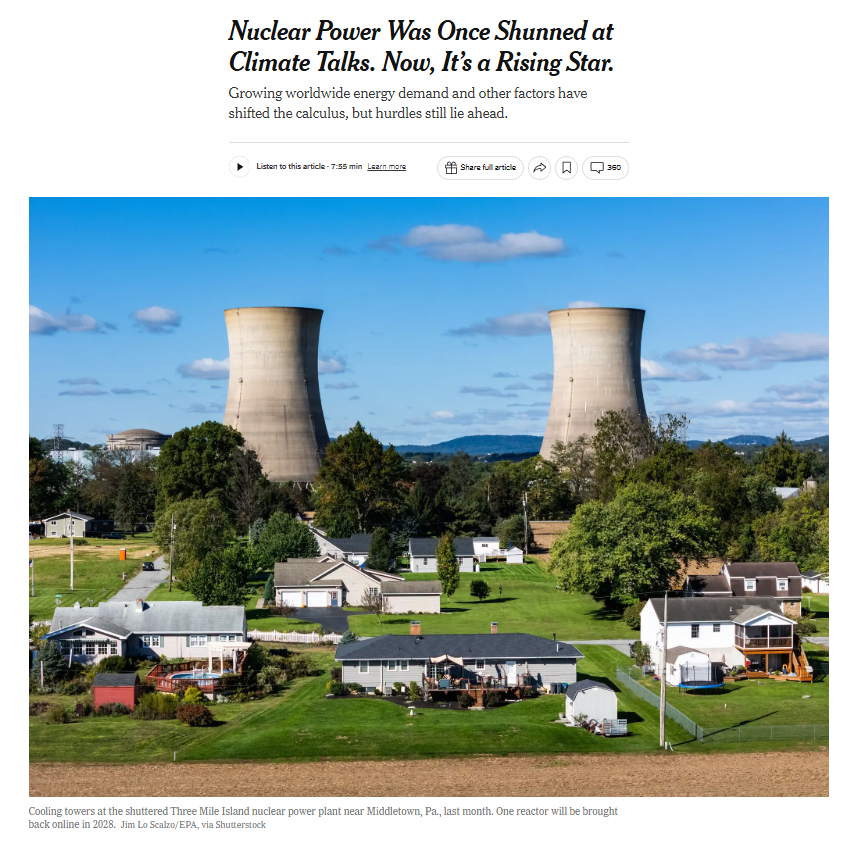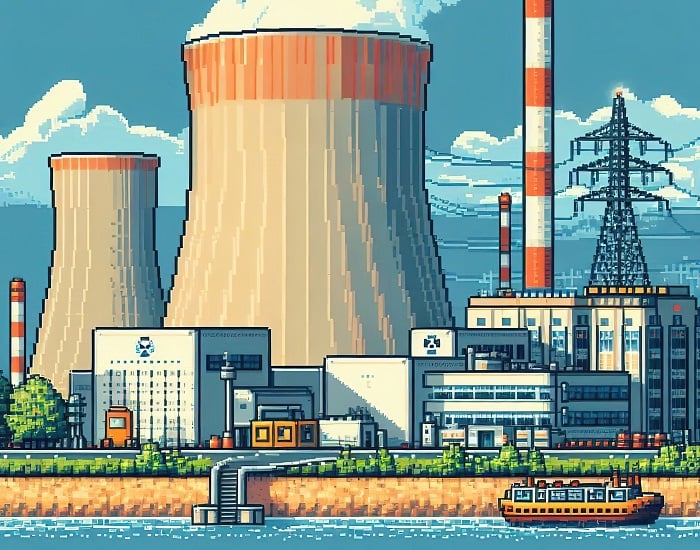If you’re looking for something that symbolizes a vibe shift in favor of nuclear energy—or, if you prefer, a new zeitgeist—look at what’s happening with Three Mile Island (TMI). In 1979, TMI’s Unit 2 suffered a partial meltdown and radiation leaks. It’s still America’s worst nuclear accident, one that badly damaged public trust in nuclear energy. TMI symbolizes the end of Atomic Age 1.0.
And now it might symbolize the start of Atomic Age 2.0. Microsoft recently agreed to pay Constellation Energy to supply nuclear power from a reopened (and undamaged) TMI Unit 1, with a restart targeted for 2028. Indeed, a photograph of TMI’s two cooling towers is used to illustrate a weekend New York Times piece on the global nuclear revival, “Nuclear Power Was Once Shunned at Climate Talks. Now, It’s a Rising Star.” The NYT reports on how nuclear power is rapidly gaining support at global climate talks, with 28 countries now pledging to triple nuclear capacity by 2050 to fight climate change.

Of course, increasing global interest in nuclear is an even more important socio-political data point in the vibe shift. From the NYT piece;
Sama Bilbao y Leon has been attending the annual United Nations climate change talks since 1999, when she was a student of nuclear engineering. And for most of that time, she said, people didn’t want to discuss nuclear power at all. “We had antinuclear groups saying, ‘What are you doing here? Leave!’” she said. … “It’s a whole different dynamic today,” said Dr. Bilbao y Leon, who now leads the World Nuclear Association, an industry trade group. “A lot more people are open to talking about nuclear power as a solution.”
And here’s yet another bit of vibe-shift evidence, via a new Financial Times piece, “Restart of Three Mile Island tests US appetite for nuclear revival.” It’s not just that a TMI reactor was selected to reopen, it’s the details of the agreement that really tell an encouraging story:
Microsoft is paying between $110 and $115 per MWh for electricity under the 20-year power supply deal agreed with Constellation, according to Jefferies. The investment bank said this was roughly double the price of standard power deals in the region.
The economic story here flips the script for TMI, by the way. While low natural gas prices from the shale boom previously forced its undamaged reactor to close in 2019, today’s surging electricity demand is creating new opportunities for nuclear power. The growth of data centers, a boom in domestic manufacturing, and increasing electric vehicle adoption are expected to double the rate of electricity demand growth in the coming decade. (Fun fact: The explosive growth of AI and data centers is creating massive new electricity demand equivalent to adding another Japan’s worth of power consumption by 2026, according to JPMorgan.”)
To those tailwinds pushing energy demand, I would also add that climate change has shifted the risk-benefit calculation, with nuclear’s generation of steady carbon-free electricity increasingly outweighing lingering safety concerns, whether from TMI, Chernobyl, or Fukushima. This is what you’re seeing play out at climate talks. Moreover, small modular reactors offer a potential solution to traditional nuclear’s cost and timeline challenges through their simpler, factory-built design.
Both articles are encouraging for nuclear proponents, overall. Let the vibe shift continue and strengthen—aided, we should hope, by an upgrade to woefully outdated government systems and procedures to handle permitting faster (maybe a good Department of Government Efficiency target)—fix environmental laws that slow down construction without actually protecting the environment, provide steady government support such as the federal loan guarantees in the TMI deal, and get states to create clearer rules for nuclear projects.
